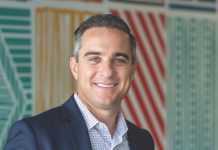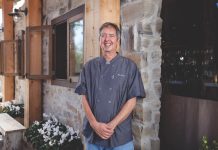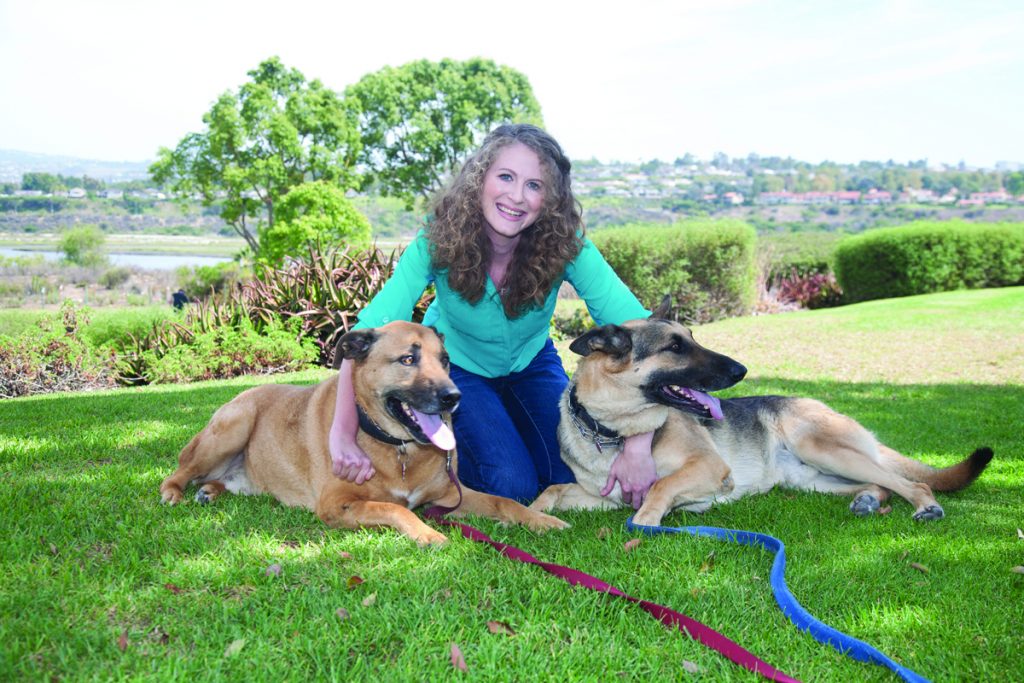
Michelle Wulfestieg, a stroke survivor and executive director of the Southern California Hospice Foundation, shares her inspirational story of overcoming challenges and serving others.
By Sharon Stello
After suffering a stroke at age 11, radiation treatment caused Michelle Wulfestieg to become partially paralyzed. She had trouble using her right arm and leg, and doctors said she wouldn’t live past her 20s due to the arterio-venous malformation (AVM), tangled veins and arteries in her brain that would eventually cause another stroke. Nevertheless, growing up in Anza, Calif., near Idyllwild, she played on her high school volleyball team, became class president and traveled to Europe. In college, she participated in the Semester at Sea program and even went sky diving. Then, after falling in love and marrying her college sweetheart as a young adult, she suffered another stroke that caused the paralysis to become worse after slipping into a coma and nearly dying. But she never let any of this stop her, always pushing forward to meet her goals.
Only months after the debilitating second stroke, while still relearning how to read, use a fork and brush her teeth, the Newport Beach resident—with a friend’s help—studied for and passed the comprehensive exam required to finally earn her graduate degree in organizational leadership. She went on to write an award-winning autobiography, “All We Have is Today,” which she typed one-handed over the course of four-and-a-half years while taking memoir-writing classes at the local senior center.
In addition to being a published writer, she also serves as executive director of the Southern California Hospice Foundation, based in Costa Mesa, where she helps grant final wishes to terminally ill patients young and old, introducing them to celebrities and planning weddings so they can finally say “I do” to longtime boyfriends or girlfriends before they pass away. Now, she’s spearheading the foundation’s effort to build the first social model hospice house in Orange County, which would provide a place for terminally ill patients to live and receive 24-hour care in addition to medical treatment by a hospice team when they have no family to care for them or anywhere else to go.
For her dedication, care and compassion for those at the end of their lives, Wulfestieg has won an Oliver Halsell Care Award from OC’s Fairhaven Memorial Park & Mortuary, to be presented during a ceremony next month. Wulfestieg, 35, who lives in Newport Beach with her husband, Steven, and their daughter, Bailey, often shares her inspiring story as a motivational speaker to give others hope. She took time to talk with us about overcoming adversity to make a difference in the community.
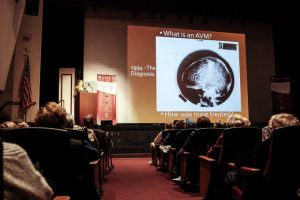
After the strokes, how did you cope with those day-to-day challenges?
I think I was able to overcome those challenges and obstacles by having a good support system. My mom was really instrumental and she always pushed me not to feel sorry for myself. Not to dwell on it. This was my reality and I had to just deal with it and really make lemonade out of lemons. It’s cliche, but it’s true. I think that it’s easy to get stuck and it’s easy to feel sorry for yourself.
And I think when anybody goes through any kind of catastrophic event or illness in their life or grief, loss of a loved one, they’re going to experience that, and that’s normal and that’s OK. But you come to a point where you have to make the conscious decision to move on and to really accept that this is your new reality and figure out ways to adapt. … I was really good at adapting and being resourceful and putting people in my life who wanted to help me and see me succeed as opposed to people who wanted to coddle me or feel sorry for me or help me to become stuck in my own swamp of sadness.
And then, as I became older, I began to serve and volunteer and I realized, “Well, my reality isn’t that bad compared to a lot of other people,” you know? I think when you go out and you help people who have problems, you realize, “OK, it could be worse.”
Do you know when that turning point was for you, when you finally accepted your new reality?
It was some time in middle school. I had a coach. That was the turning point. He was like, “You have to tie your shoes. I’m not going to tie your shoes for you. You have to do it yourself. This is your new reality. … Learn how to do it.” You know? And then I did it and I was like, “Oh, I can do it.” And then that’s been the story of my life ever since. It’s like, “Wow, I can do it.” I can work full time. I can be a wife. I can be a mom. I can get Harrison Ford to come visit a patient. It’s having that belief. I think a lot of people give up before they even try because they decide in advance it’s too hard. And, of course, you’re going to fail—many times—before you succeed. But the fact that you don’t give up, that’s what makes a difference. Because you’ll come to a point where there’s a breakthrough and you’re able to solve the problem … or make a difference or change the world.
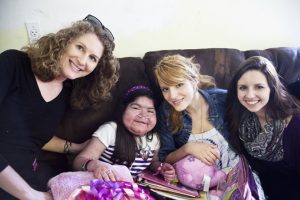
Is there one wish you’ve granted for a patient that stands out in your mind that was really memorable or really touched you?
I think all of them touch me. … We had a patient who was 63 years old and she wanted to commit her love to her partner of 13 years or so, and so we were able to partner with a number of people in the community in order to make her wedding wish come true. … And we worked recently with Island Hotel and Casey Reinhardt, of Casey’s Cupcakes, for a little girl who was 13 years old and she loved cooking and she wanted to be a cooking queen for the day. And so we were able to arrange that and make that happen. … It was just really beautiful. And about a week and a half later she passed away.
… We had a patient who was 94 years old that just wanted to go around the racetrack at … [Auto Club Speedway in] Fontana. So we put her in a pace car and she went for 20 laps at 120 mph. That was insane. I went for three laps and I was like, “Get me out of here, this is crazy.” … We had a patient that wanted to connect with Oprah. And we were able to do … a video chat with her, which was really cool. We’ve worked with Angels baseball. … We had a little boy who … loved skateboarding, so he called himself Tony Hawk. And so we were able to make an arrangement for Tony Hawk to come and meet with him and do skateboarding tricks in the parking lot and all kinds of stuff.
How did you get started in this kind of work?
I took a class in college, a death and dying class. And a part of the assignment was either to volunteer at a nursing facility or volunteer with hospice. And my patient who I’d been assigned to lived in a nursing facility and, like me, she had also had a stroke. And when I shared with her that I’d had a stroke, she immediately opened up to me and we had this bond, really a bond that transcended age and time. … So, when she passed away two months later, her family asked me to give the eulogy at her funeral. … And, afterward, one of the sons came up to me and said, “There were things about my mom I never knew because I never took the time to ask.” … And, so, I knew at that moment that I had found my calling and that I was meant to work for hospice and throughout my life and the series of things that have happened to me, God has reaffirmed that consistently that hospice is where I’m meant to be.
You probably get asked this all the time, but isn’t it sad or depressing to work with people who are dying?
I get teary-eyed and there are moments I cry and I’m sad and, at the same time, I guess I go back to my feelings of you’re helping them, you’re giving them a gift, you’re making a difference. And I can’t change their reality, but I can still give them hope. Maybe not hope for a cure, but hope for dignity, for quality of life, for comfort, for knowing that they accomplished something, that they did something great, that they made a difference. At the end of the day, I think that’s what people want. They want to make a difference. They want to know that their life mattered.
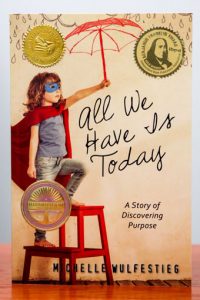
What is one piece of advice or inspiration that you share with people at your motivational talks?
It depends on the audience and who I’m speaking to. I speak at a lot of colleges about hospice. I do a lot of talks to women’s groups, talk about near-death experiences, churches. So, really, the audience gears kind of what my main message is. But … I just encourage people that no matter what they are going through, no matter what trials they face or what obstacles are in front of them, there is a way out and there is hope. And all of it is for a reason.
… Because I was not expected to live to be 30 years old. So, I knew my whole life that I really wasn’t going to have a long life. And then, when they removed the AVM when I was 25, now I have a normal life expectancy, but I’m still very disabled and it’s still very hard for me to move, to talk, to do everything. So, it’s easy to become bitter. It’s easy to become angry, especially with God when you have all these issues, but at the same time, if I would have gotten stuck in my bitterness, I wouldn’t have done all this to help other people. So, sometimes, God uses the broken. I’m disabled, I’ve been on the brink of death and I feel like I’ve been chosen to serve the dying.
Is there anything else that you want to add or you want people to know?
I want people to know that there is always hope in any situation. And the best way to get out of feeling stuck is to serve. In hospice, there are a number of ways to serve. You could become a hospice volunteer and provide emotional support and companionship at the bedside of patients. You could be a part of our guild and we meet monthly and create bags of love for newly admitted hospice patients, which includes things like a lap blanket, hand sanitizer, a list of resources, prayer cards, things like that. … There’s always a way to serve, always a way to give back.


